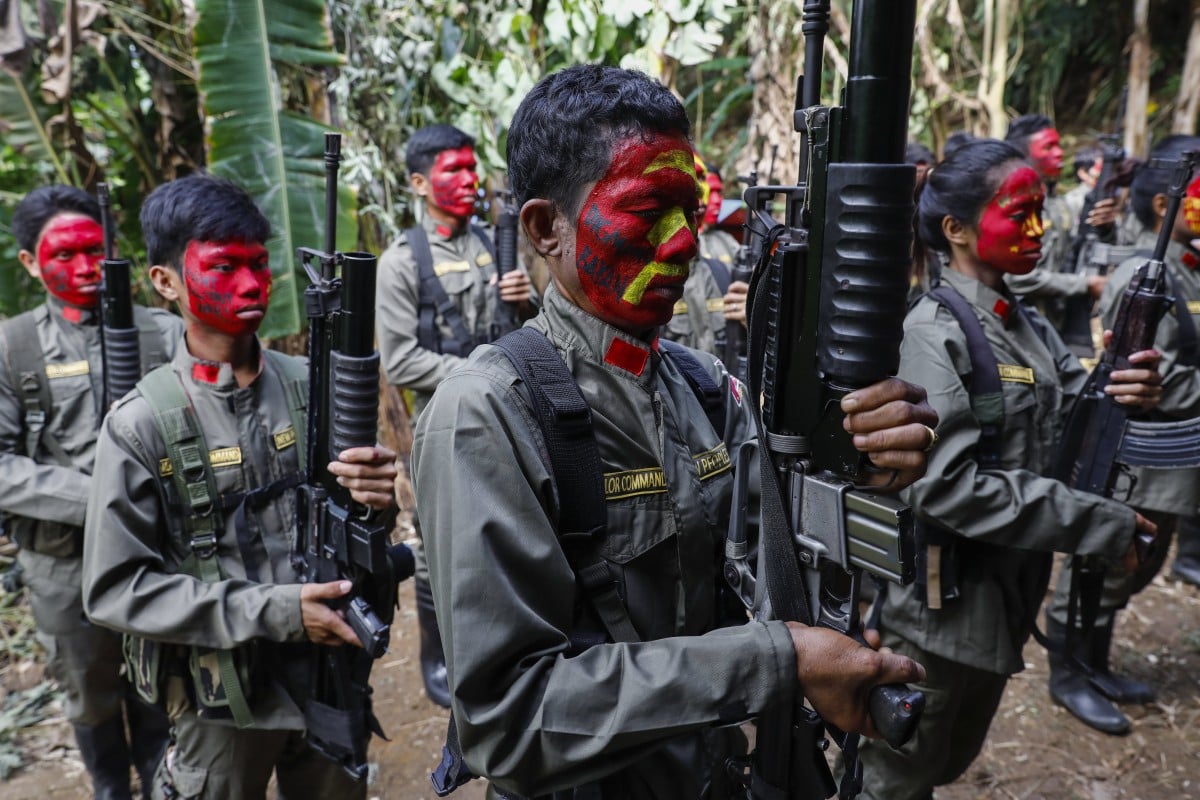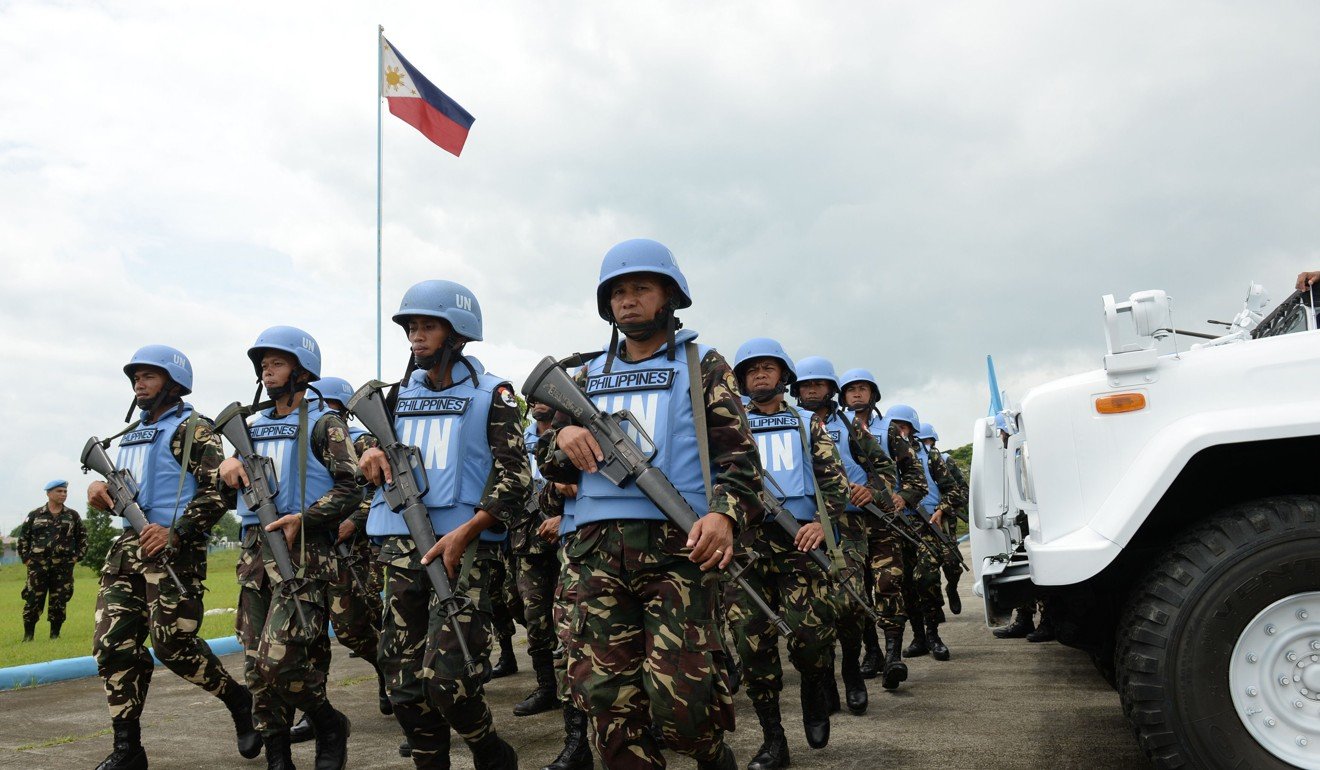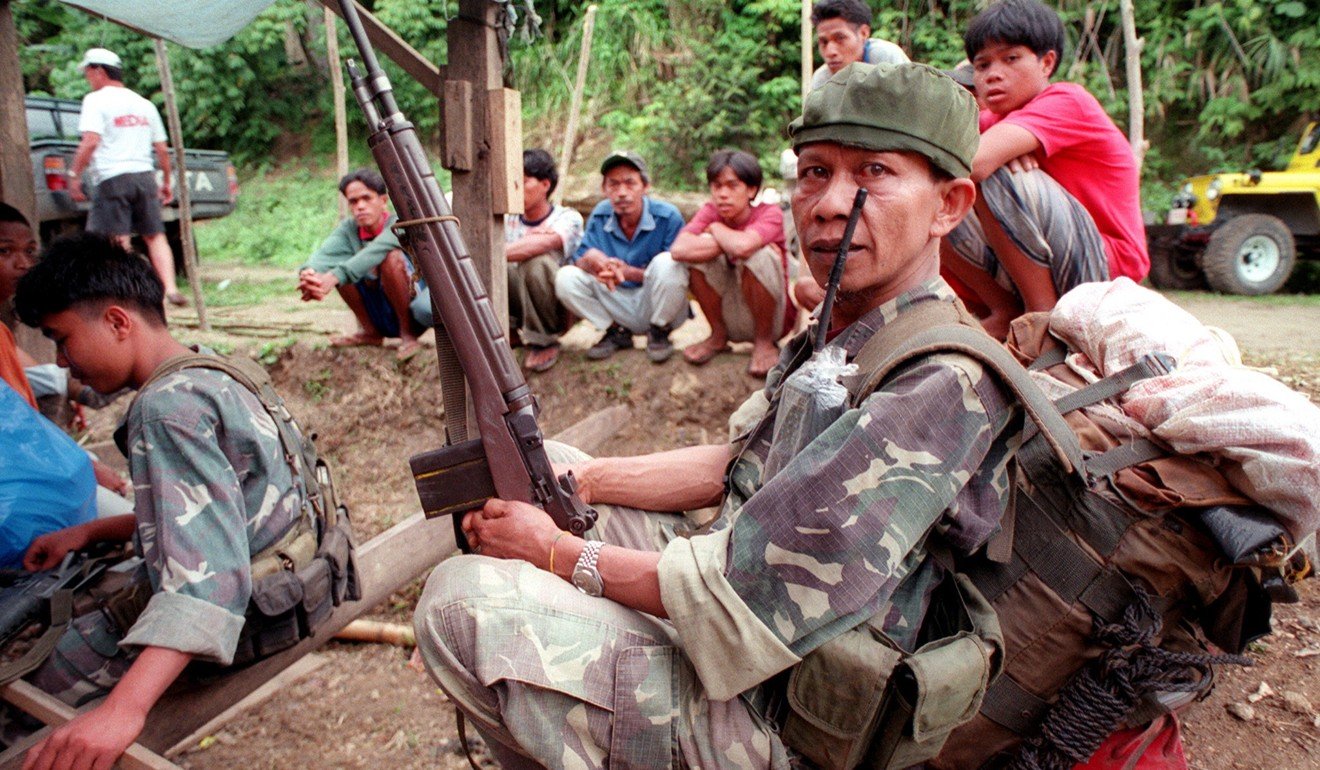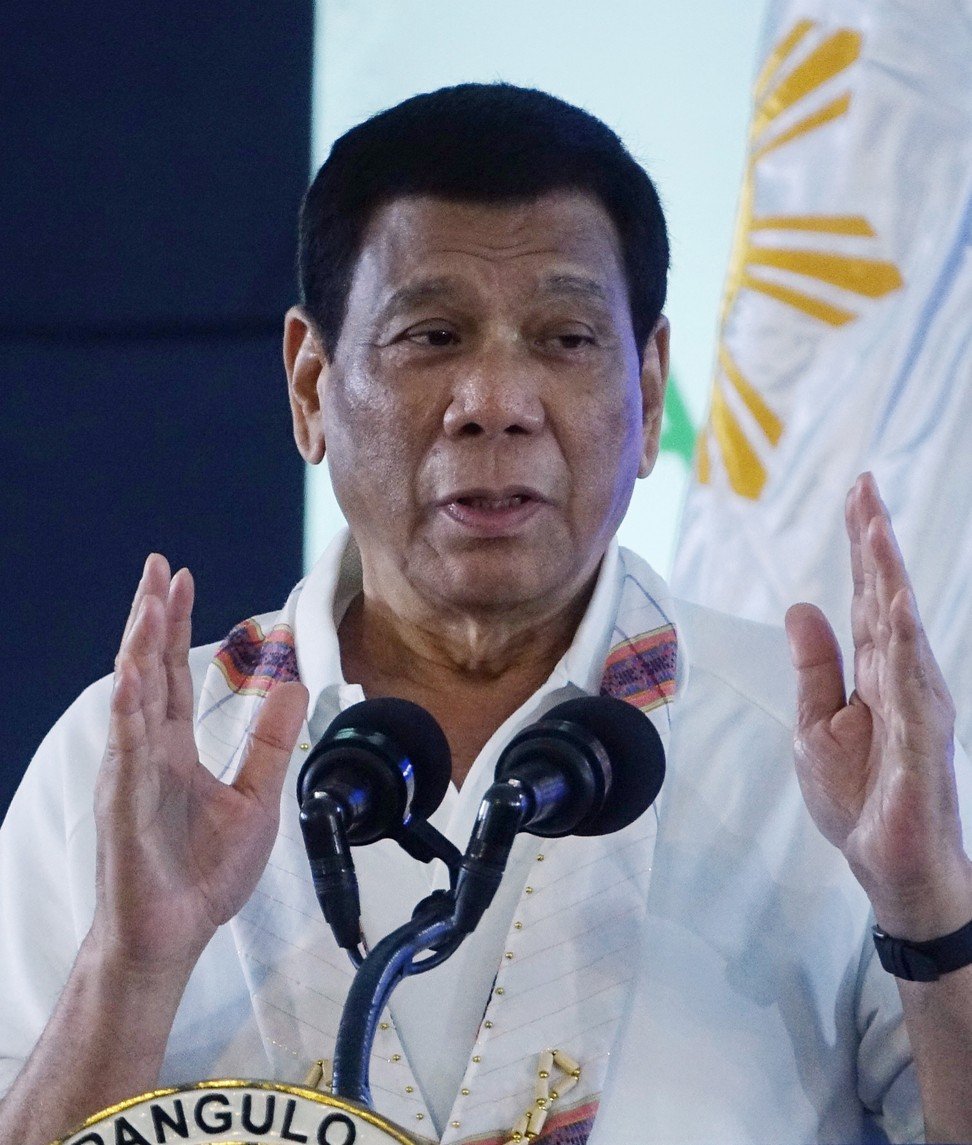- Devoted to overthrowing the government, the rebels have never politically controlled any province or even a single city
- However, from bases in the forests and mountains across the country, guerillas have continued fighting for decades

Fighters of the New People’s Army. Photo: EPA
On September 10, President Rodrigo Duterte ordered the Philippine military to crush the long-running communist rebellion in an “all-out war”, insisting “if I can, I will end the insurgency problem within my term”.
There was nothing new about the exhortation and hopeful promise: it’s been made before by previous national leaders. When she was president, Gloria Arroyo also promised an all-out war and vowed to crush the communists in three years. Instead, Arroyo finished her term in 2010 with the communists uncrushed – and she ended up in jail, accused of plunder.
The Communist Party of the Philippines (CPP), which will mark the 51st anniversary of its founding in December, has outlasted one dictator and five presidents. Young army officers who fought the insurgency when it started are now grandfathers in their 70s – if they’re still alive. Meanwhile, a new generation of communist rebels is continuing the fight in the CPP’s military arm, the New People’s Army (NPA), which was formed in 1969.
Devoted to overthrowing the government, the CPP and NPA have never politically controlled any province or even a single city. The rebels have not recovered their strength of 33 years ago but from bases in the forests and mountains across the country, the NPA’s heavily armed guerillas have waged what CPP calls “protracted war” or “armed struggle”, although critics characterise it as banditry. Rebels ambush government forces, raid towns and outposts and levy “revolutionary taxes” on private corporations.
Working under the National Democratic Front (NDF), an umbrella organisation of militant leftist groups that are “above ground” (legal) or “underground” (banned), the CPP-NPA has long been a player in national affairs.
On September 10, President Rodrigo Duterte ordered the Philippine military to crush the long-running communist rebellion in an “all-out war”, insisting “if I can, I will end the insurgency problem within my term”.
There was nothing new about the exhortation and hopeful promise: it’s been made before by previous national leaders. When she was president, Gloria Arroyo also promised an all-out war and vowed to crush the communists in three years. Instead, Arroyo finished her term in 2010 with the communists uncrushed – and she ended up in jail, accused of plunder.
The Communist Party of the Philippines (CPP), which will mark the 51st anniversary of its founding in December, has outlasted one dictator and five presidents. Young army officers who fought the insurgency when it started are now grandfathers in their 70s – if they’re still alive. Meanwhile, a new generation of communist rebels is continuing the fight in the CPP’s military arm, the New People’s Army (NPA), which was formed in 1969.
Devoted to overthrowing the government, the CPP and NPA have never politically controlled any province or even a single city. The rebels have not recovered their strength of 33 years ago but from bases in the forests and mountains across the country, the NPA’s heavily armed guerillas have waged what CPP calls “protracted war” or “armed struggle”, although critics characterise it as banditry. Rebels ambush government forces, raid towns and outposts and levy “revolutionary taxes” on private corporations.
Working under the National Democratic Front (NDF), an umbrella organisation of militant leftist groups that are “above ground” (legal) or “underground” (banned), the CPP-NPA has long been a player in national affairs.
To deal with Asia’s longest-running insurgency, various governments have tried brute force, negotiations, ceasefires and the deployment of murderous vigilante “citizen’s militias”.
President Rodrigo Duterte. Photo: EPA
HOW STRONG IS THE COMMUNIST REBELLION?
HOW STRONG IS THE COMMUNIST REBELLION?
According to Lt Col Ramon Zagala, spokesman for the Philippine Army, “the NPA is less than 4,000 and it is on a continuous decline”. It’s a dramatic reduction from 1986, when armed guerillas numbered more than 20,000, their ranks bolstered by the abuses of Ferdinand Marcos.
Jose Maria Sison, founder of the CPP, did not give specific numbers on the NPA’s strength, saying only that “the NPA has thousands of red fighters and operates in 120 guerilla fronts in 74 out of 81 Philippine provinces”. He also said the CPP has 100,000 members nationally.
DO THE COMMUNIST REBELS GET ANY SUPPORT FROM CHINA?
The CPP was founded in 1968 on Mao Zedong’s birthday and called itself a Maoist movement dedicated to overthrowing a “feudalist” state that was a “puppet” of US imperialism. In its infancy, the CPP-NPA received material support from China, including a cargo of weapons on a ship that ran aground.
When China opened itself to market reforms, the CPP distanced itself, calling China a “bogus communist country” as the Philippine communists cast themselves as true Maoists.
Now, according to Zagala, the CPP receives support from other sources: “They even mislead international organisations where they collect huge amounts of money to fund their terroristic activities.”
In the face of public concern that China is bullying the Philippines and grabbing its territory, the NDF has broadened its dedicated anti-US stance to include China.
Jose Maria Sison, founder of the CPP, did not give specific numbers on the NPA’s strength, saying only that “the NPA has thousands of red fighters and operates in 120 guerilla fronts in 74 out of 81 Philippine provinces”. He also said the CPP has 100,000 members nationally.
DO THE COMMUNIST REBELS GET ANY SUPPORT FROM CHINA?
The CPP was founded in 1968 on Mao Zedong’s birthday and called itself a Maoist movement dedicated to overthrowing a “feudalist” state that was a “puppet” of US imperialism. In its infancy, the CPP-NPA received material support from China, including a cargo of weapons on a ship that ran aground.
When China opened itself to market reforms, the CPP distanced itself, calling China a “bogus communist country” as the Philippine communists cast themselves as true Maoists.
Now, according to Zagala, the CPP receives support from other sources: “They even mislead international organisations where they collect huge amounts of money to fund their terroristic activities.”
In the face of public concern that China is bullying the Philippines and grabbing its territory, the NDF has broadened its dedicated anti-US stance to include China.

Philippine peacekeeper trainees. Photo: AFP
WHY HAS THE COMMUNIST MOVEMENT BEEN SO HARD TO DESTROY?
Government officials dismiss the CPP-NPA as a group of bandits and terrorists but the movement draws on ideas and an assessment of the country’s situation that many followers find both appealing and convincing.
“The CPP has analysed the history and current circumstances of the Filipino people,” Sison said. “It has analysed the semicolonial and semifeudal character of Philippine society and has identified the basic problems of the Filipino people, such as imperialism, feudalism and bureaucrat capitalism.”
The CPP’s founder said the only thing that can destroy the CPP is itself – “if it violates its correct revolutionary principles, commits grave errors and fails to rectify them”.
The commander-in-chief Duterte is an unabashed ruffian who publicly calls on his armed minions to go on rampagesJose Maria Sison, CPP founder
This nearly happened when Marcos was overthrown in 1986, and the communists played no role in his exit. This led to a division within the party, between the “reaffirmists”, who wanted to continue armed struggle, and the “rejectionists”, who felt the movement should come to terms with the system and work within it. The result was a murderous internal blood-letting which paralysed the CPP. The reaffirmist view won and the revolution continues.
Zagala said the movement employs “deception, organisation and mobilisation in order to attract individuals, especially the youth who are idealistic and sometimes gullible”. He said the CCP “espouses their national democratic revolution as the only cure for all our problems and that a change in our system of government is what the country needs”.
WHY HAS THE COMMUNIST MOVEMENT BEEN SO HARD TO DESTROY?
Government officials dismiss the CPP-NPA as a group of bandits and terrorists but the movement draws on ideas and an assessment of the country’s situation that many followers find both appealing and convincing.
“The CPP has analysed the history and current circumstances of the Filipino people,” Sison said. “It has analysed the semicolonial and semifeudal character of Philippine society and has identified the basic problems of the Filipino people, such as imperialism, feudalism and bureaucrat capitalism.”
The CPP’s founder said the only thing that can destroy the CPP is itself – “if it violates its correct revolutionary principles, commits grave errors and fails to rectify them”.
The commander-in-chief Duterte is an unabashed ruffian who publicly calls on his armed minions to go on rampagesJose Maria Sison, CPP founder
This nearly happened when Marcos was overthrown in 1986, and the communists played no role in his exit. This led to a division within the party, between the “reaffirmists”, who wanted to continue armed struggle, and the “rejectionists”, who felt the movement should come to terms with the system and work within it. The result was a murderous internal blood-letting which paralysed the CPP. The reaffirmist view won and the revolution continues.
Zagala said the movement employs “deception, organisation and mobilisation in order to attract individuals, especially the youth who are idealistic and sometimes gullible”. He said the CCP “espouses their national democratic revolution as the only cure for all our problems and that a change in our system of government is what the country needs”.

Villagers huddle around two armed communist NPA guerrillas. Photo: AFP
HOW WILL DUTERTE’S STRATEGY DIFFER FROM PREVIOUS ONES?
The government has deployed a mix of military and police force, intelligence work and infiltration, negotiations and local government reform.
HOW WILL DUTERTE’S STRATEGY DIFFER FROM PREVIOUS ONES?
The government has deployed a mix of military and police force, intelligence work and infiltration, negotiations and local government reform.
For years, Duterte expressed sympathy for communists. Indeed, Sison had been his teacher at college in the 1960s. As mayor of Davao, Duterte appeared in a video saying “mabuhay ang NPA [long live the NPA]”. When he became president he appointed several leftists to senior government positions.
However, the honeymoon did not last long. Enraged when NPA rebels continued attacking government forces, Duterte broke off negotiations with the communists and dismissed the leftist appointees.
‘Let’s just go to war’: Rodrigo Duterte cancels peace talks
Fidel Ramos legalised the communist party in the 1990s but Duterte has labelled it a terrorist group and vowed to destroy it.
For Sison, it’s all more of the same.
“The differences are not in substance but merely in style,” he said. “The commander-in-chief Duterte is an unabashed ruffian who publicly calls on his armed minions to go on rampages of mass murder and to rape women.”
According to Zagala, “the communist threat lasted this long because we have not realised that a purely military solution is not enough to solve this problem. It needs the collaboration of different government agencies, stakeholders and even the general public.
Duterte offers US$500 kill bounty for Philippines communist rebels
“We cannot destroy the communist idea that drives the armed struggle but we do need to destroy the idea that the solution lies in the national democratic revolution.”
The state forces, though, have been notoriously crude in their approach, casting anyone who criticises the government as a “leftist” or a “communist”.
Sison predicted that far from crushing the communists, the military might just overthrow Duterte “as a consequence of his treasonous acts and the intolerable rot he has abetted within the armed forces”.
https://www.scmp.com/week-asia/politics/article/3027414/explained-philippines-communist-rebellion-asias-longest-running


No comments:
Post a Comment
Note: Only a member of this blog may post a comment.